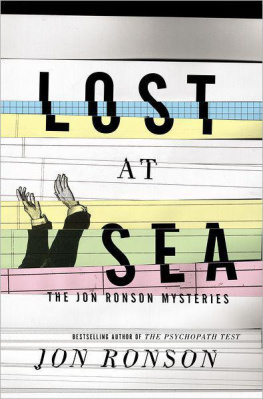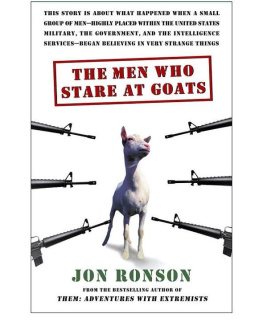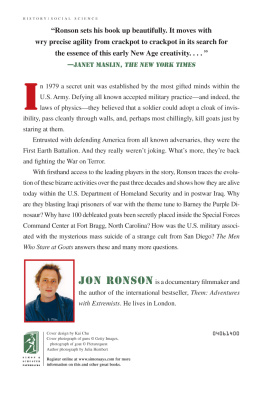For Elaine
Contents
BRAVEHEART
This story begins in early January 2012 when I noticed that another Jon Ronson had started posting on Twitter. His photograph was a photograph of my face. His Twitter name was @jon_ronson. His most recent tweet, which appeared as I stared in surprise at his timeline, read: Going home. Gotta get the recipe for a huge plate of guarana and mussel in a bap with mayonnaise :D #yummy.
Who are you? I tweeted him.
Watching #Seinfeld. I would love a big plate of celeriac, grouper and sour cream kebab with lemongrass #foodie, he tweeted.
I didnt know what to do.
The next morning I checked @jon_ronsons timeline before I checked my own. In the night he had tweeted, Im dreaming something about #time and #cock.
He had twenty followers. Some were people I knew from real life, who were probably wondering why Id suddenly become so passionate about fusion cooking and candid about dreaming about cock.
I did some digging. I discovered that a young researcher, formerly of Warwick University, called Luke Robert Mason had a few weeks earlier posted a comment on the Guardian site. It was in response to a short video I had made about spambots. Weve built Jon his very own infomorph, he wrote. You can follow him on Twitter here: @jon_ronson.
Oh, so its some kind of spambot, I thought. OK. This will be fine. Luke Robert Mason must have thought I would like the spambot. When he finds out that I dont hell remove it.
So I tweeted him: Hi!! Will you take down your spambot please?
Ten minutes passed. Then he replied, We prefer the term infomorph.
I frowned. But its taken my identity, I wrote.
The infomorph isnt taking your identity, he wrote back. It is repurposing social media data into an infomorphic aesthetic.
I felt tightness in my chest.
#woohoo damn, Im in the mood for a tidy plate of onion grill with crusty bread. #foodie, @jon_ronson tweeted.
I was at war with a robot version of myself.
A month passed. @jon_ronson was tweeting twenty times a day about its whirlwind of social engagements, its soirees and wide circle of friends. It now had fifty followers. They were getting a disastrously misrepresentative depiction of my views on soirees and friends.
The spambot left me feeling powerless and sullied. My identity had been redefined all wrong by strangers and I had no recourse.
I tweeted Luke Robert Mason. If he was adamant that he wouldnt take down his spambot, perhaps we could at least meet? I could film the encounter and put it on YouTube. He agreed, writing that hed be glad to explain the philosophy behind the infomorph. I replied that Id certainly be interested to learn the philosophy behind the spambot.
I rented a room in Central London. He arrived with two other men - the team behind the spambot. All three were academics. They had met at the University of Warwick. Luke was the youngest, handsome, in his twenties, a researcher in technology and Cyberculture and director of the Virtual Futures conference, according to his online CV. David Bausola looked like a rakish teacher, the sort of person who might speak at a conference on the literature of Aleister Crowley. He was a creative technologist and the CEO of the digital agency, Philter Phactory. Dan OHara had a shaved head and eyes that were piercing and annoyed-looking. His jaw was clenched. He was in his late thirties, a lecturer in English and American Literature at the University of Cologne. Before that hed been a lecturer at Oxford. Hed written a book about J. G. Ballard called Extreme Metaphors and another book called Thomas Pynchon: Schizophrenia & Social Control. As far as I understood it, David Bausola had done the actual building of the spambot, while the two other men provided research and consultancy.
I suggested they sit in a row on the sofa so I could film them all in a single shot. Dan OHara gave the others a glance.
Lets play along, he said to them. They all sat, with Dan in the middle.
What do you mean by play along? I asked him.
Its about psychological control, he said.
Do you think my having you in a row on the sofa is my way of psychologically controlling you? I asked.
Absolutely, said Dan.
In what way? I asked.
I do that with students, said Dan. I put myself in a separate chair and put the students in a row on the sofa.
Why would you want to psychologically control some students? I asked.
Dan looked briefly worried that hed been caught saying something eerie. In order to control the learning environment, he said.
Is this making you feel uncomfortable? I asked him.
No, not really, said Dan. Are you uncomfortable?
Yes, I said.
Why? Dan asked.
I spelled out my grievances. Academics, I began, dont swoop into a persons life uninvited and use him for some kind of academic exercise and when I ask you to take it down youre, Oh its not a spambot, its an infomorph.
Dan nodded. He leaned forward. There must be lots of Jon Ronsons out there? he began. People with your name? Yes?
I looked suspiciously at him. Im sure there are people with my name, I replied, carefully.
Ive got the same problem, said Dan, with a smile. Theres another academic out there with my name.
You dont have exactly the same problem as me, I said, because my exact problem is that three strangers have stolen my identity and have created a robot version of me and are refusing to take it down even though they come from respectable universities and give TEDx talks.
Dan let out a long-suffering sigh. Youre saying, There is only one Jon Ronson, he said. Youre proposing yourself as the real McCoy, as it were, and you want to maintain that integrity and authenticity. Yes?
I stared at him.
I think we feel annoyed with you, Dan continued, because were not quite persuaded by that. We think theres already a layer of artifice and its your online personality - the brand Jon Ronson - youre trying to protect. Yeah?
NO, ITS JUST ME TWEETING, I yelled.
The Internet is not the real world, said Dan.
I write my tweets, I replied. And I press Send. So its me on Twitter.
We glared at each other.
Thats not academic, I said. Thats not postmodern. Thats the fact of it.
This is bizarre, Dan said. I find it really strange - the way youre approaching this. You must be one of the very few people who have chosen to come on Twitter and use their own name as their Twitter name. Who does that? And thats why Im a little suspicious of your motives, Jon. Thats why I say I think youre using it as brand management.
I said nothing, but to this day it kills me that it didnt cross my mind to point out to him that Luke Robert Masons Twitter name is @LukeRobertMason.
Our conversation continued like this for an hour. I told Dan that I have never used the term brand management in my life. Language like that is alien to me, I said. And thats the same with your spambot. Its language is different to mine.
Yes, the three men agreed in unison.
And thats whats annoying me so much, I explained. Its a misrepresentation of me.
Youd like it to be more like you? Dan said.
Id like it to not exist, I said.
Thats bizarre, said Dan. He let out an incredulous whistle. I find something psychologically interesting about that.
Why? I said.
I find that quite aggressive, he said. Youd like to kill these algorithms? You must feel threatened in some way. He gave me a concerned look. We dont go around generally trying to kill things we find annoying.
Youre a TROLL! I yelled.
After the interview was over I staggered out into the London afternoon. I dreaded uploading the footage onto YouTube because Id been so screechy. I steeled myself for comments mocking my screechiness and I posted it. I left it ten minutes. Then, with apprehension, I had a look.
Next page











